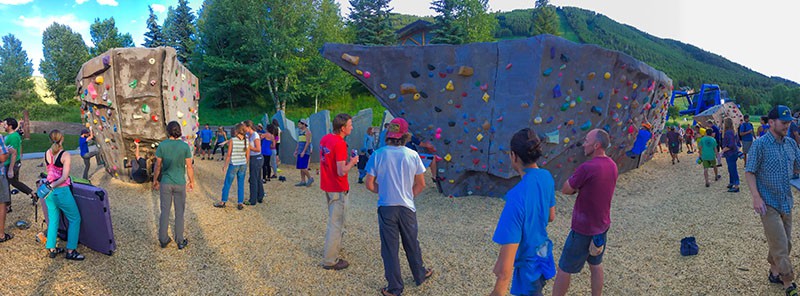Read The
Current Issue
Climbing for all
A guide to the Teton Boulder Park
By Samantha Simma

Photo by David J Swift
AT THE BASE of Snow King Mountain, Phil Baux Park brims with the potential for activities: You can set up a slackline, picnic, toss horseshoes, climb on jungle gyms, or play Frisbee. At the center of it all, rising from wood chips, are three manmade “boulders” covered with colorful climbing holds. Meet the Teton Boulder Park. This park-within-a-park is a partnership among the Town of Jackson, Teton County Parks and Recreation Department, and the Teton climbing community. An interactive memorial to mountaineering in the Tetons, it honors the history of Teton mountaineering and climbers who have died in the range and also seeks to inspire present and future climbers, all while providing the valley’s only public artificial rock climbing area.
You can just climb and ignore the colorful strips of tape beneath holds, but the strips mark routes of varying difficulty. If you want to challenge yourself, climb to the top of a boulder using only the holds marked with the same color of tape.
The Guides Boulder features between 20 and 30 routes. The moniker is a nod to the Exum Mountain Guides, who helped raise funds for this boulder. JH
• The Town Pump, an 11-week series of climbing competitions, happens here every Tuesday evening during the summer. There’s live music and prizes for the climbers—individuals and teams— who do the most/hardest routes during a two-hour period. It costs $45 to enter the series or $10 to drop in for one comp; money raised goes toward maintaining the boulder park.
• A wall of history describes twelve significant mountaineering events in the Tetons. Renny Jackson, who has summited dozens of peaks in the Tetons and was one of Grand Teton National Park’s elite Jenny Lake Climbing Rangers for 35 years, chose which events to include.
• The addition of a fourth boulder is currently being discussed. The “Ranger Boulder” would honor the Jenny Lake Climbing Rangers, who have performed search-and-rescue missions in GTNP since the 1950s and saved hundreds of lives. An accompanying interpretative display will share the group’s history.
• A kids’ boulder with about ten routes features large hand holds, bold colors, and easy routes.
• A collection of 8-foot-tall granite slabs mimics the circle found atop the Enclosure, a 13,285-foot-high rock outcrop to the west of the Grand Teton that was likely summitted by pioneer Teton climbers Nathaniel Langford and James Stevenson in 1872. Many believe the circle was constructed by Native Americans to serve as a shelter and/or as a site for vision quest rituals. The slabs in the boulder park come from quarries near Idaho’s City of Rocks National Reserve, another popular climbing area. The central stone bears the inscription, “For those we’ve lost in the mountains.”
• The boulders were made in Bend, Oregon, by Entre-Prises, a climbing wall, boulder, and hold manufacturer. Each boulder has an internal steel skeleton, but the exterior is Entre-Prises proprietary FreeForm, a composite material created specifically for outdoor climbing walls to limit cracking. The boulders were delivered to Jackson by truck and then assembled on site.
• The Boxcar Boulder, so named because during its design phase it looked like a boxcar, is the biggest of the park’s three boulders. It is about 12 feet tall and ranges between 30 and 40 feet long. The boulder, which weighs six tons and was delivered in two pieces, holds between 60 and 70 routes. At the time of the park’s construction, it was the largest human-made outdoor climbing boulder known (it has since been surpassed in size).




